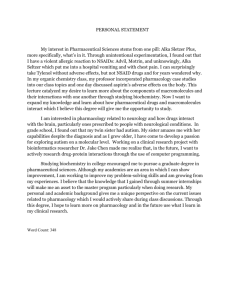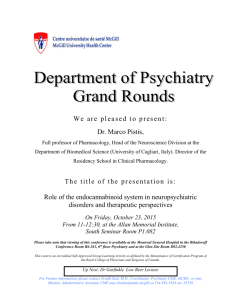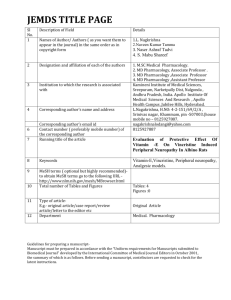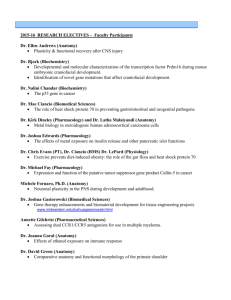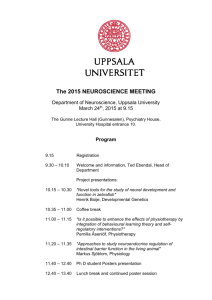Integrating basic and clinical sciences in the post-gateway era
advertisement
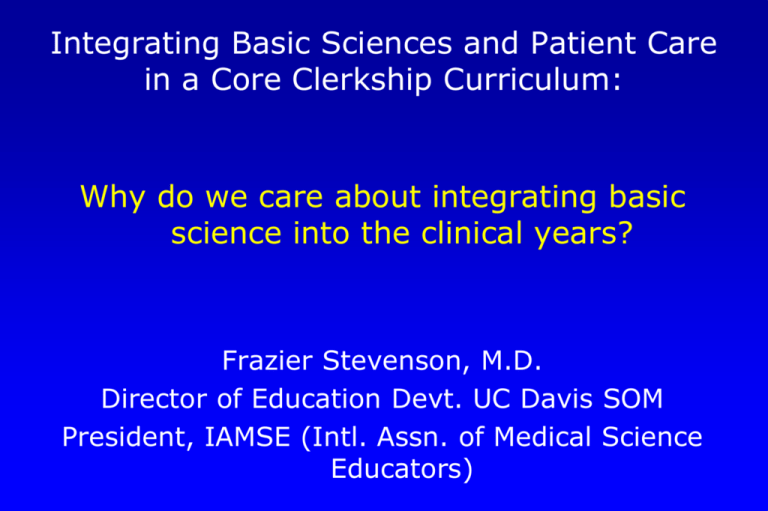
Integrating Basic Sciences and Patient Care in a Core Clerkship Curriculum: Why do we care about integrating basic science into the clinical years? Frazier Stevenson, M.D. Director of Education Devt. UC Davis SOM President, IAMSE (Intl. Assn. of Medical Science Educators) Yale SOM Curriculum 1875 Year 2 •Dispensary •Chemistry •Practical Anatomy •Embryology •Physiological Chemistry •Chemistry of Urine •Chemical Laboratory •Histology •Pathology •Theory and Practice •Ophthalmology •Obstetrics •Surgery Year 3 •Dispensary •Surgery Clinic •Eye Clinic •Medical Clinic •Hospital •Toxicology •Diseases of Women and Children •Lectures on Insanity Abraham Flexner Flexner Report, 1908 • Admission to a medical school should require, at minimum, a high school diploma and at least two years of university study, primarily devoted to basic science. • The length of medical education be four years, 2 years of basic science and 2 years of clinical practice • Proprietary medical schools should either close or be incorporated into existing universities, because a standalone medical school would have to charge too much in order to break even. • Medical schools should appoint full-time clinical professors--"true university teachers, barred from all but charity practice, in the interest of teaching." UCSF 1980 1 2 Anatomy Biochemistry Histology Physiology Genetics Endocrinology Human Behavior Immunology Pathology Microbiology Pharmacology Human Sexuality Statistics Psychiatry 3 Clerkships: Surgery Pediatrics Internal Medicine OB-GYN 4 Electives Basic Science Selective Senior Surgery Anaesthesia Neurology Psychiatry Intro to Clinical Medicine Case Western 1955 1 2 3 4 Normal Diseases Neurologic Musculoskeletal Pulmonary Hematology Endocrine Renal Neurologic Musculoskeletal Pulmonary Hematology Endocrine Renal Clerkships Surgery (12 months) Internal Medicine Electives Cardiac Cardiac Pediatrics Neurology OB-GYN Psychiatry UCSF CURRICULUM (February 2003) YEAR 1 Prologue Organs (heart, lungs, kidneys, GI) Gross Anatomy Cell Biology Biochemistry General Pathology General Pharmacology Anatomy review Physiology Histo-Pathology Pharmacology Clinical Interlude Cancer Brain, Mind, and Behavior Oncology Hematology Genetics Biochemistry Histo-Pathology Pharmacology Neurobiology Neuroanatomy Neurology Psychiatry Histo-Pathology Pharmacology Foundations of Patient Care YEAR 2 Immunology, Infection, and Inflammation Microbiology Immunology Rheumatology Histo-Pathology Pharmacology Metabolism and Nutrition Life Cycle Physiology Gastroenterology Nutrition Endocrinology Biochemistry Histo-Pathology Pharmacology Genetics Embryology Repro Physiology OB/GYN Pediatrics Geriatrics Dev..Psychol. Pharmacology Integration and Review Foundations of Patient Care YEAR 3 Internal Medicine Family Comm. Med INTERSESSIONS Obstetrics-Gynecology Surgical Specialties Surgery Psychiatry Pediatrics Neurology Anaesthesia Student Perspective of Medical Biochemistry Source: frommedskoll.com 8 % responding agree or strongly agree AAMC Graduation Questionnaire: Basic Science Education “Basic science content was sufficiently integrated” 80 75 70 65 60 55 50 45 40 35 30 0.0 All schools UCD 2.5 1998 5.0 7.5 10.0 12.5 2008 How well did these basic science courses prepare you for the clinical clerkships? 1998 2008 Anatomy 79 85 Biochemistry 42 53 Biostats/Epi 40 51 Genetics 45 60 Immunology 70 70 Histology 51 61 Microbiology 76 75 Neuroscience 68 74 Pathology 85 82 Pharmacology 80 66 Physiology 83 83 IAMSE 2009-- Flexner Revisited: Defining the Role and Value of the Basic Sciences in Medical Education Goals: 1. Define and describe the sciences that constitute the foundation of medicine 2. Identify the role and value of the sciences and scientific thinking in medical education 3. Identify the best practices of when, where and how the foundation sciences should be incorporated into medical education 11 Questions to be Addressed: 1. What are the sciences that constitute the foundation for medical practice of the future? 2. What is the value and role of the foundational sciences in medical education? 3. When and how should these foundational sciences be incorporated into the medical education curriculum? 4. What sciences could/should be pre-requisite components of the undergraduate medical curriculum (i.e. be part of the pre-medical requirements)? 5. What are examples of the best practices for incorporation of the foundational sciences in the medical education curriculum? 12 What are the sciences that constitute the foundation for medical practice of the future? • All basic sciences taught currently will remain important for the future. • Normal structure and function are the basis for understanding pathophysiology • Depth/detail may vary considerably – must be informed by clinical relevance – a moving target requiring diligent monitoring and assessment 13 How to assess clinical relevance? • Key vocabulary • Basis for understanding disease – Common diseases algorithms, practice guidelines – Complex or unusual diseases deeper learning and understanding required • Changing clinical practice creates a persistent and dynamic relationship between basic and clinical sciences 14 Designing a new basic science curriculum: WHAT? • ability to access basic science mechanisms to solve clinical problems • critical thinking skills, problem solving skills • group interaction and communication skills • ability to formulate research questions and hypotheses • ability to find and use information to answer these questions 15 Designing a new basic science curriculum: WHEN? • When – all years – A USMLE mandate • Rather than a bolus of “ghettoized” information once, distribute content across the continuum • Revisit science cyclically (upward spiral) • Use opportunities to build upon previous learning 16 Designing a new basic science curriculum: WHEN? Clinical Sciences Basic Sciences Year 1 Year 4 Clinical Sciences Basic Sciences Year 1 Year 4 See Milbank Report 17 HOW? 18

